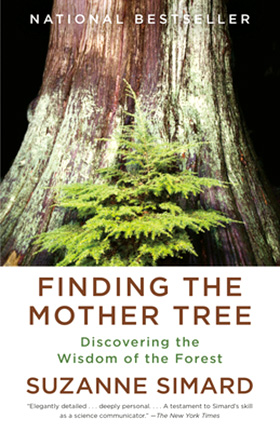
Suzanne Simard grew up in a family well acquainted with trees. For generations, they were loggers in British Columbia, Canada. Her very personal book starts with glimpses of her family’s story and moves into her own as she begins work with a logging company. Her job was to understand why plantations (areas of newly planted seedlings after clear cutting) weren’t growing well. Was it because the lumber company had planted seedlings of a different species which would be more profitable than the original native trees they had cut? Or because the seedlings were planted in grids instead of clumps? Or was it the planting’s timing? Or were the seedlings not getting enough water?
She dug up some of the newly planted seedlings and found their root tips brown and dry. When she dug up same-sized native seedlings which had sprouted through humus at the roots of nearby older trees, she found the root tips healthy and encased in webs of yellow fungus – mycorrhiza, living in a symbiotic relationship with a tree’s roots.
Did the web of threads from the fungus transfer water and other nutrients to this native seedling in some kind of integrated underground system? This became her first question. Her research early on began to challenge the lumber company and Canadian government policies, especially the practice of using massive amounts of glyphosate herbicides to keep other trees from growing near recently planted seedlings of the commercially valuable firs.
Whether trees compete or collaborate became another question. Her data showed that plantings of Douglas fir grew only half as fast without birch trees nearby transferring nitrogen and sugars along mycorrhizal networks. Older trees cooperated with younger trees of the same species and also other species! Yet, foresters were not convinced by her data.
Through many years to follow, including earning her masters and PhD degrees, planting thousands of seedlings, and doing multiple experiments with her students and in collaboration with other researchers, Simard’s work has led to the concept of “mother trees” as hubs in the life and renewal of forest health. Her research is increasingly accepted and better funded. The use of glyphosates is decreasing. She is involved in a huge undertaking with nine experimental forests with various climate and soil conditions across British Columbia. Her question now is: “Which combination of harvesting and planting will be most resilient to the stresses the planet is facing?”
While my mind zoned out reading about the numerous experiments, I admire the creativity, time, and patience her research took. Her writing is crisp, with visuals you can see, such as: “Branches burst with new growth over a fleece of jade needles.” I went on a journey with Simard and ended up totally convinced that Finding the Mother Tree and preserving her and her fungal networks are key.


Pingback: MUSHROOMS – the fungus among us | mid Rio Grande Times